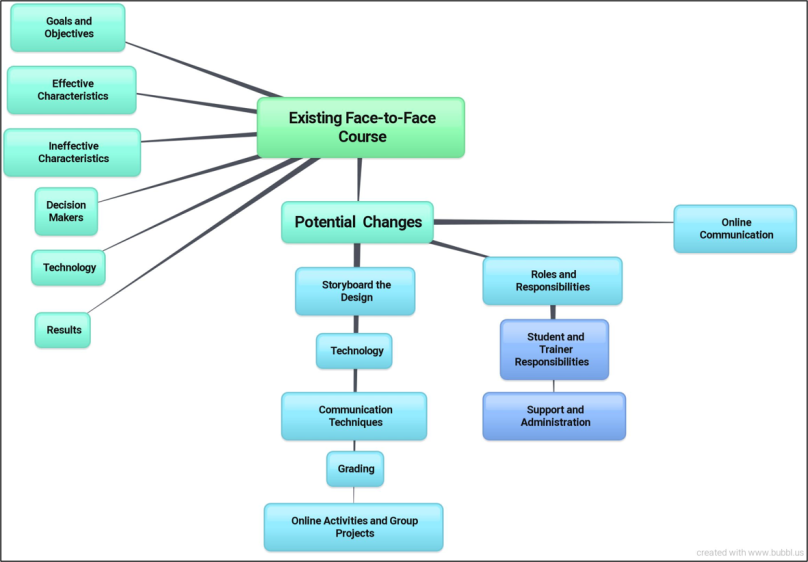It is interesting to note that distance learning is well over one hundred years old and yet, many today may consider it a new form of learning (Simonson, Smaldino, & Zvacek, (2015). This is in part because distance learning is becoming more of a mainstream form of education (Naidu, (2014). At one time, distance learning might have been viewed as traveling by foot or horse for miles to reach a school, but as we read, correspondence through the mail was how it formally began (Simonson, Smaldino, & Zvacek, (2015).
Before starting this course, I defined distance learning similarly to how others may describe it today. My definition was synchronous or asynchronous learning distributed via the Internet in which instructor and participant were geographically separated. I considered it somewhat of a disruptor (Simonson, (2015). While this definition still applies, there is more to consider when attempting to define it.
There are factors that must be considered when describing distance learning. One of these factors has been present since distance learning began in 1833 (Simonson, Smaldino, & Zvacek, (2015). This factor is technology. Technology is a component of a distance learning solution. Consider audio, video, 3D graphics and other means as parts of a distance learning solution (Simonson, Smaldino, & Zvacek, (2015). These should be used to effectively convey content and contribute to learner understanding (Simonson, Smaldino, & Zvacek, (2015). Regardless of what point is viewed on the distance learning timeline, technology of the day also helped to deliver learning. Mail delivery was the transport method at one time and now one of the transport methods is the Internet (Simonson, Smaldino, & Zvacek, (2015).
In addition to technology, the audience determines the definition of distance learning. This is in part because of the technology found in their geographical locations but also because of their proximity to traditional education outlets. Their perceptions of distance learning are also tied to socioeconomic factors that may dictate how they pursue education (Huett, Moller, Foshay, & Coleman, (2008). Additionally, a group’s definition of education can influence distance learning’s meaning. For example, if we look at distance learning as a form of communication, Morse code using light flashes between naval ships could be considered a method of distance learning. Morse Code and light are forms of technology utilized to relay information and learning objectives. When information has been delivered and acknowledged, the learning objective has been met.
When taking this information into account, my definition has changed and affected my view of how distance learning will evolve. My definition is heavily influenced by technology. However, my definition of technology as it relates to distance learning has changed. Before I began this course, I considered the Internet the sole technology used to define distance learning. I only considered technology to be the transport component of distance learning. There are in fact many other delivery systems including the Intranet, mail, telephone and any other means that allows two parties to deliver information over distance. In addition, technology does more than transport. It can shape content to appeal to a specific audience’s needs or make content more compelling.
An exciting aspect of distance learning is that as technology advances, what and how content will be delivered will change. Global society will continue to have greater access to information and educational opportunities. Our world has been described as a global village. Technology has made the world smaller. We no longer need to leave our homes and offices to communicate and learn. This provides distance learning with an unlimited audience. In addition, learning topics supported by distance learning will increase as delivery methods can manage more complex content. Improvements in technology can change and improve learning methods provided that sound instructional design principals are incorporated. What an exciting time to be part of the learning development process.
Huett, J., Moller, L., Foshay, W., & Coleman, C. (2008). The evolution of distance education: Implications for instructional design on the potential of the web (Part 3: K12). TechTrends, 52(5), 63–67.
Moller, L., Foshay, W., & Huett, J. (2008). The evolution of distance education: Implications for instructional design on the potential of the web (Part 1: Training and development). TechTrends, 52(3), 70–75
Naidu, S. (2014). Looking back, looking forward: the invention and reinvention of distance education. Distance Education, 35(3), 263-270.
Simonson, M. (2015). Distance Education as a Disruptive Technology. Distance Learning, 12(1), 47.
Simonson, M., Smaldino, S., & Zvacek, S. (2015). Teaching and learning at a distance:Foundations of distance education (6th ed.) Charlotte, NC: Information Age Publishing.



 An example is the use of blogs in online assignments. There is an abundance of blogs and their topics on the Internet. Taking this one step further, it is amazing to see the use to technology that is incorporated into blogs that make them more engaging. Mind maps, videos, images, audio and text combine to make topic engaging to the blog reader. In this way, online communication is improved.
An example is the use of blogs in online assignments. There is an abundance of blogs and their topics on the Internet. Taking this one step further, it is amazing to see the use to technology that is incorporated into blogs that make them more engaging. Mind maps, videos, images, audio and text combine to make topic engaging to the blog reader. In this way, online communication is improved. The focus should be on delivering content that supports the learning objectives and goals regardless of venue (Morrison, Ross, Kalman, & Kemp 2013). Click on the
The focus should be on delivering content that supports the learning objectives and goals regardless of venue (Morrison, Ross, Kalman, & Kemp 2013). Click on the 
